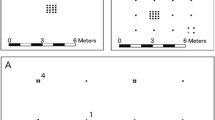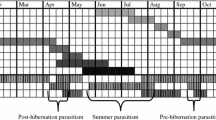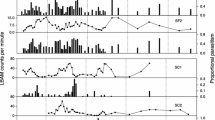Abstract
The population dynamics of insects in a spatially fragmented environment were studied by examining three main aspects of their ecology, namely, rates of local population extinction, density dependence in population change, and movements between populations. Ten phytophagous insects and seven parasitoids inhabiting the flowerheads of two herbaceous plants, Centaurea nigra and Arctium minus, were studied by monitoring their populations on more than 50 patches of each plant, scattered over 5 km2 of arable farmland. The results were used to test the relative importance of immigration and of local population regulation to population persistence. This paper describes the rates of local extinction of the various species and the density-dependent factors operating on their populations. Local extinction was found to be a regular feature of these populations, especially on the smaller patches of the plants. Density dependence was identified in the changes in population sizes between generations of eight species (five herbivores and three parasitoids). Parasitoids appeared to be incapable of regulating their host populations, in the four host species for which we have data. Populations of all species were, however, limited by their food resources, and their numbers tracked changes, both spatially and temporally, in resource availability. The implications of these findings to population theory are discussed.
Similar content being viewed by others
References
Boer PJ den (1986) Density dependence and the stabilisation of animal populations. 1. The winter moth Oecologia 69: 507–512
Boer PJ den (1987) Density dependence and the stabilisation of animal populations. 2. The pine looper. Neth J Zool 7:220–237
Boer PJ den (1988) Density dependence and the stabilisation of animal populations. 3: The winter moth reconsidered. Oecologia 75:161–168
Bulmer MG (1975) The statistical analysis of density dependence. Biometrics 31:901–911
Clapham AR, Tutin TG, Warburg EF (1981) Excursion flora of the British Isles, 3rd edn Cambridge University Press, Cambridge
Dempster JP (1983) The natural control of populations of butter flies and moths. Biol Rev 58:461–481
Dempster JP, Pollard E (1981) Fluctuations in resource availability and insect populations. Oecologia 50:412–416
Dempster JP, Pollard E (1986) Spatial heterogeneity, stocasticity and the detection of density dependence in animal populations. Oikos 46:413–416
Dempster JP, Atkinson DA, French MC (in press) The spatial dynamics of insect populations exploiting a patchy food resource. II. Movements between patches. Oecologia 104:354–362
Emmet AM (1991) Chart showing the life history and habits of the British Lepidoptera, In: Emmet AM, Heath J (eds) The moths and butterflies of Great Britain and Ireland, vol 7, part 2. Harley, Colchester, pp 61–303
Halley JM, Dempster JP (in press) The spatial population dynamics of insects exploiting a patchy food resouce. III. A model study of local persistence. J Appl Ecol
Hanski I, Gilpin M (1991) Metapopulation dynamics: brief history and conceptual domain. Biol J Linn Soc 42:3–16
Hassell MP (1985) Insect natural enemies as regulating factors. J Anim Ecol 54:323–334
Kuno E (1971) Sampling error as a misleading artifact in “key factor analysis”. Res Popul Ecol 13:28–45
May RE (ed) (1976) Theoretical ecology, principles and applications. Blackwell Oxford
Milne A (1957) The natural control of insect populations. Can Entomol 89:193–213
Moore DM, Tutin TG, Walters SM (eds) (1975) Flora Europaea 4 (Compositae). Cambridge University Press, Cambridge
Nicholson AJ (1933) The balance of animal populations. J Anim Ecol 2 Suppl 1:132–178
Nicholson AJ (1954) An outline of the dynamics of animal populations. Aust J Zool 2:9–65
Pollard E, Lakhani KH Rothery P (1987) The detection of density dependence from a series of annual censuses. Ecology 68: 2046–2055
Pollard E, Rothery P (1994) A simple stochastic model for resource-limited insect populations. Oikos 69:287–294
Purrington FF (1970) Ecology of Metzneria lappella (Lepidoptera: Gelechiidae) and its hymenopterous parasites in eastern North Dakota. Ann Entomol Soc Am 69:942–945
Romstock-Volkl M (1990) Population dynamics of Tephritis conura Loew (Diptera: Tephritidae): determinants of density from three trophic levels. J Anim Ecol 59:251–268
Southwood TRE, Jepson WF (1962) Studies on the populations of Oscinella frit L. (Dipt: Chloropidae) in an oat crop. J Anim Ecol 31:481–495
Straw NA (1986) Resource limitation and competition in two tephritid flies attacking the flowerheads of lesser burdock (Arctium minus). Ph D thesis, University of Cambridge
Straw NA (1989a) The timing of oviposition and larval growth by two tephritid fly species in relation to host-plant development. Ecol Entomol 14:443–454
Straw NA (1989b) Evidence for an oviposition-deterring pheromone in Tephritis bardanae (Schrank) (Diptera: Tephritidae). Oecologia 78:121–130
Straw NA (1991) Resource limitation of tephritid flies on lesser burdock, Arctium minus (Hill) Bernth (Compositae). Oecologia 86:492–502
Varley GC (1937) The life-history of some Trypetid flies, with description of the early stages (Diptera). Proc R Entomol Soc Lond A 12:109–122
Varley GC (1947) The natural control of population balance in the knapweed gall-fly (Urophora jaceana). J Anim Ecol 16: 139–187
Varley GC, Gradwell GR (1960) Key factors in population studies J Anim Ecol 29:399–401
Zwolfer H (1994) Structure and biomass transfer in food webs: stability, fluctuations and network control. In: Schulze E-D (ed) Flux control in biological systems from enzymes to populations and ecosystems. Academic Press, San Diego, pp 365–419
Author information
Authors and Affiliations
Rights and permissions
About this article
Cite this article
Dempster, J.P., Atkinson, D.A. & Cheesman, O.D. The spatial population dynamics of insects exploiting a patchy food resource. Oecologia 104, 340–353 (1995). https://doi.org/10.1007/BF00328370
Received:
Accepted:
Issue Date:
DOI: https://doi.org/10.1007/BF00328370




